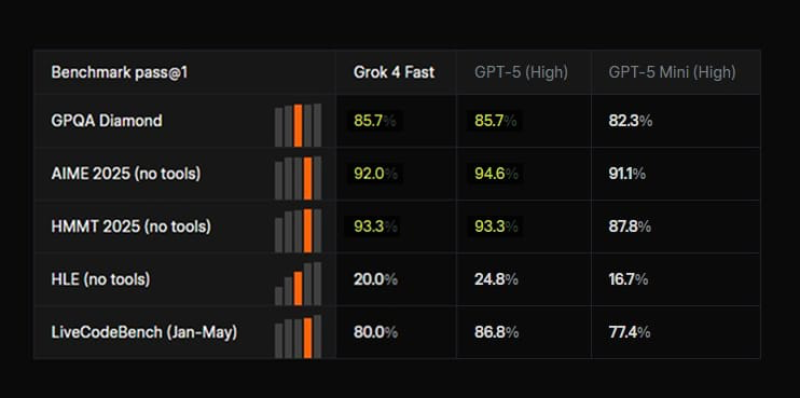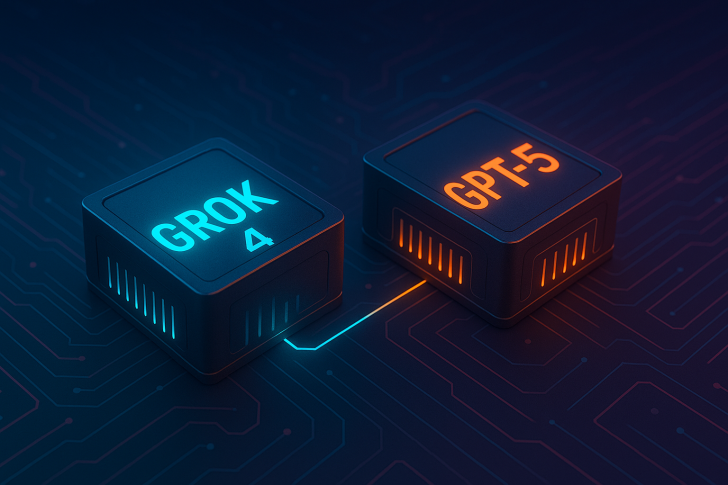The AI landscape just got more competitive. Recent benchmark data reveals that Grok 4 Fast, a model that's been flying under the radar, matches GPT-5's reasoning capabilities while dramatically undercutting it on price and speed. For developers and businesses looking to deploy powerful AI without breaking the bank, this could be a game-changer.
Benchmark Results Show Near-Identical Performance
Fresh benchmark data comparing Grok 4 Fast against GPT-5 High and GPT-5 Mini shows the newcomer holding its own across major reasoning and coding tests.

In most categories, Grok 4 Fast matches or closely trails GPT-5 High while consistently outperforming GPT-5 Mini:
- GPQA Diamond: 85.7% (Grok 4 Fast) = 85.7% (GPT-5 High) vs 82.3% (GPT-5 Mini)
- AIME 2025 (no tools): 92.0% vs 94.6% vs 91.1%
- HMMT 2025 (no tools): 93.3% vs 93.3% vs 87.8%
- HLE (no tools): 20.0% vs 24.8% vs 16.7%
- LiveCodeBench (Jan–May): 80.0% vs 86.8% vs 77.4%
The numbers tell a compelling story: you're getting GPT-5-class intelligence without the GPT-5-class price tag.
The Real Breakthrough: Efficiency at Scale
Where Grok 4 Fast truly shines is in its economics. The cost differential is staggering: input tokens are 84% cheaper, output tokens are 95% cheaper, and the model runs about 150% faster, clocking around 344 tokens per second compared to GPT-5's roughly 138. In practical terms, GPT-5 reportedly charges $1.25 per million input tokens and $10 per million output tokens, while Grok 4 Fast comes in at just $0.20 and $0.50 respectively. That works out to a total cost reduction of nearly 96% for comparable performance.
What This Means for the Industry
This kind of cost-performance ratio could fundamentally change how companies approach AI deployment. Startups that couldn't afford enterprise-level AI can now access it. Researchers running thousands of experiments can do so without burning through grants. Companies building AI copilots, code generators, and analytics tools can scale faster and cheaper. The speed advantage also opens doors for latency-sensitive applications like real-time coding assistance, algorithmic trading, or live data analysis where every millisecond and every dollar counts.
The Awareness Gap
Despite these impressive specs, many developers still haven't heard of Grok 4 Fast. The model has received minimal marketing push and faces the gravitational pull of OpenAI's brand dominance. But as word spreads through AI communities and benchmark data circulates, that's starting to change. Engineers focused on infrastructure costs and deployment efficiency are taking notice.
A Shift Toward Efficiency
Grok 4 Fast represents something bigger than just another model release. It signals a potential shift in the AI arms race, from pursuing maximum intelligence regardless of cost to optimizing intelligence per dollar spent. If these results hold up under wider testing and real-world use, they could pressure the entire ecosystem toward building more efficient, accessible models. The era of "good enough, way cheaper, and much faster" might just be beginning.
 Peter Smith
Peter Smith

 Peter Smith
Peter Smith


